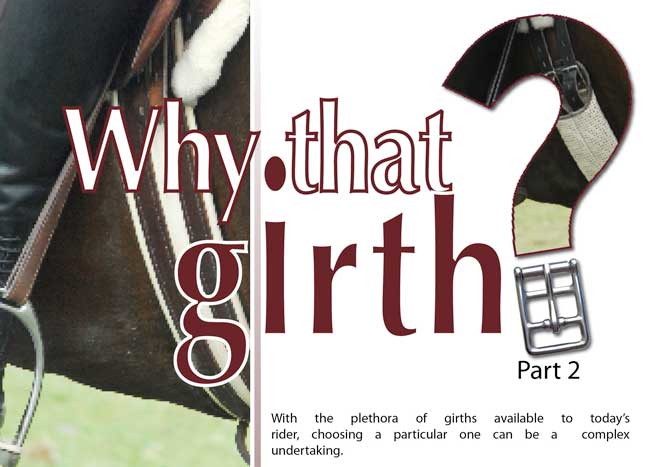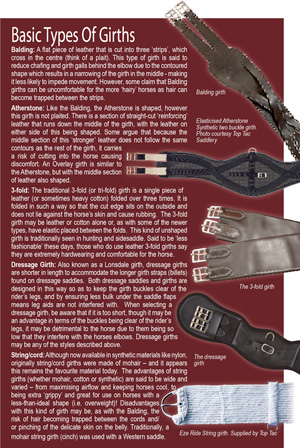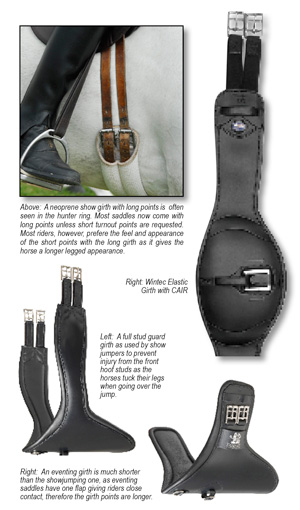
by Kaye Meynell
The tack one chooses, and how they use it (see Tight Girths April May 13) on their horse is a complex issue. For some, the final choice is the result of hours of dedicated research into what is the best style, most hardwearing material or of greatest comfort to the horse. For others - and more than likely the majority - the sheer range of equipment available in today’s saddleries and tack shops is just too overwhelming, and a good recommendation from a trainer or friend is the ultimate deciding factor.
Whichever method is employed, selecting riding equipment that suits the individual rider and horse is important – especially when one considers the number of years these big ticket items are expected to remain functional. If there was one item of tack that a rider could be expected to agonise over, it is probably the saddle, thanks to the huge amount of research that has emerged over the years that demonstrates just how detrimental an ill-fitting saddle can be to the horse both in terms of general muscle damage and also as a cause of lower limb lameness. However, naturally following on from the type of saddle is consideration of the best kind of girth, both in terms of function and also its effectiveness in keeping the saddle in place during exercise without affecting performance (see the recent article regarding tight girths in the April/May 2013 issue of Hoofbeats). 
If asked to describe what a girth was, to somebody who had never seen one, the explanation would be simple: a strip of material that lies on the underside of the barrel of the horse and attaches on both sides to the saddle – usually by way of two or three straps (also known as billets) with buckles. Yet the plethora of girths available to today’s rider can actually make the task of choosing a particular one a much more complex undertaking than it was 10 years ago. Cotton, leather, neoprene or string? Shaped or straight? The list is endless, and whilst the final choice will more than likely come down to personal preference (of rider or horse) there are perhaps features of individual girths that make them more suited to certain horses or those working in a particular discipline.
Not too many years ago there were just a handful of girth styles, these being the Balding; Atherton (or Overlay); 3-fold; string, and dressage or ‘Lonsdale’ girth. Now, whilst these ‘basic’ girths are still widely available and used there are many new designs that incorporate contouring, elastic and other high tech materials that aim to distribute pressure more evenly, prevent injuries, mould to the shape of individual horses and more! Take, for example, the Jumping girth - also known as a stud girth, belly guard girth or kick girth; this style of girth incorporates a large, roughly oval shaped panel in the centre that aims to protect the horse’s sternum from impact by the front feet/shoes/studs when the horse tucks its forelegs up during jumping. Some swear that using a jumping girth has solved the problem of their horses becoming sore after jumping - perhaps because they distribute the pressure over a larger area - whilst others say it can help horses that have begun refusing fences. Then there are the ‘pressure relief’ styles of girth, an example being the ‘Pressure Eze’ girth by Equi-prene, designed to minimise pressure on the pectoral muscles - which run along the breastbone – therefore allowing them more ‘freedom’ to work properly. Pressure relief girths, in addition to being significantly wider in the middle, are often also shaped to be ‘cut away’ behind the elbow, again to maximise range of movement and prevent pinching and galling.
A survey of general Aussie horse owners found that there is no clear ‘favourite’ girth; in fact there remains a huge amount of variation, with many factors coming into play such as sensitivity of the horse, preference of the rider, cost, or guidance from a vet/chiropractor/saddle fitter. Some found simply adding a girth cover to the existing girth was helpful – especially for ‘girthy’ horses. Not surprisingly there were firm opinions voiced when it came to the use of girths with elastic components – whether they featured elastic at one end, elastic at both ends, or elastic incorporated into the body of the girth itself - and riders also reported that there was generally no consensus amongst their saddle fitters or veterinarians when they were called upon to provide help selecting a girth for a horse displaying discomfort when under saddle. Some were advocates of elastic, though many stipulated that the elastic must be at both ends of the girth in order to avoid uneven stretching and pressure points on the horse’s barrel; some however strongly advised against any amount of stretch – usually citing the risk of overtightening as the main cause for concern. 
Whilst no one girth was found to be the best, several were mentioned time and again from those surveyed, and these included girths by Wintec and Pressure-Eze. “The high performance synthetic materials in Wintec offer a significant performance advantage in girths, as they are anti-galling, lightweight, easy-care and highly durable,” say Wintec, “they are the most popular brand of girths in the world, loved for their practicality and comfort as they can be simply hosed off after each ride, ensuring they remain clean, supple and comfortable for the horses”. Another popular type were those made by Equinez. Equinez is a company designing and supplying dressage and general purpose girths with elastic, “These girths are really kind on horses and we get a lot of feedback from riders who have horses that are girthy that no longer have issues when using the Equinez girths,” says Clare Carey from Equinez. “All our girths are made from premium NZ Wool; we chose wool because it has so many great properties: it is natural, warm, soft, breathes, absorbs moisture away from the skin and doesn’t rub”.
What was abundantly clear from the survey was that, for almost every rider, the comfort of their horse was paramount. The vast majority had tried several types of girths over the years and were taking great pains to ‘listen’ to what their horses were telling them with regards to whether a particular girth was working for them or not. Price obviously had a part to play too, though surprisingly did not appear to be the deciding factor - many had spent hundreds of dollars on a single girth, and lots had a different girth for training/schooling at home and for competition. The sheer range of girths available can be overwhelming for even the most seasoned rider; one only has to perform a keyword search for ‘girth’ on any online equestrian forum to see that a huge number of people are struggling with their decision on which to buy! With so many styles, shapes and fabrics on offer, it’s easy to become confused attempting to find the perfect girth for one particular horse, let alone one that will be best suited to a horse working within several disciplines. 
Chatting to other riders about what they have found works well for them can be a good starting point, but be aware that it may be a case of trial and error before a girth that suits both horse and rider can be found. Take the time to consider the size and conformation of the horse in order to identify any possible issues, such as sensitive skin or a very round barrel, prior to trialling a new girth, and utilise the expert knowledge of local saddle fitters and tack shops where possible.
WHAT THE PROFESSIONALS SAY
Heath Ryan - Rozzie and I both use Bates and Wintec dressage or jumping girths on all the horses we ride; these horses range from youngstock just broken-in to Grand Prix competition horses. These girths have the CAIR® system built in, are shaped to disperse pressure evenly across the horse’s sternum and the shaped girths are wider than traditional girths giving greater stability for both horse and rider. The even dispersal of pressure and greater width ensures that our horses are able to train and compete at top levels without us having to worry about unnecessary pinching or chaffing. As you can imagine our horses comfort and performance are of utmost importance and the design of Bates and Wintec girths certainly help this. We have traveled all over the world in competition - always with Bates equipment. Heath has been the Australian Three Day Event Champion on three occasions, the Australian Grand Prix Dressage Champion twice and has represented Australia at WEG and the Olympics.
Hayley Beresford - I predominantly ride in the Bates CAIR® girths as my horses find them comfortable and they are easy to clean. I have one very short horse that rides in a Bates Wintec girth as she doesn’t like the width of the CAIR® range, and I have one horse with over-sensitive skin that I ride in a Bates Wintec girth with a sheepskin underlay. It is important that your horse is comfortable with your equipment if you expect him to perform; the girth should be tight, for your safety and saddle stability, but I like elasticity in girths to allow easy breathing and mobility for the horse. I find the Bates and Wintec range the best on the market. Hayley is an International Dressage rider, trainer and coach from WA now living and competing in Europe. Visit www.hayleyberesford.com for more info.
Brett Parbery - I use the neoprene-covered girths that are straight (i.e. not contoured), and with no elastic - because then you know how tight it is. With elastic you never know. There are more modern and fancy girths these days but I find these simple and easy to clean…and they work for me! Brett was in the top 10 riders in the world Equestrian Games Kentucky 2010 and has held 12 Australian Championships, competed on 3 Australian teams and been amongst the final 6 for Olympic selection for Beijing and London. Visit www.brettparbery.com.au for more info.
Stuart Tinney - I use the Wintec elastic girth with CAIR®, especially in dressage. I find the central air cushion, elasticated fabric and anatomically-shaped design help distribute pressure evenly over a larger area- thereby relieving pressure points and preventing over tightening. When jumping I use the Bates Elastic Stud Girth with CAIR®. Stuart is an Australian gold medal eventer who won a team gold medal at the 2000 Summer Olympics and competed at the 2004 Summer Olympics.
Clayton Fredericks – I use the Southern Stars Long Mini Stud Girth with triple fold elastic on both ends and roller buckles for easy girthing up. This girth has a slightly smaller guard, which I find suits horses that are sensitive and/or don’t like a big guard (like those of a smaller build). We find our Southern Stars dressage girth is very popular with riders as whilst it is elasticated it offers more of a ‘gentle’ give without compromising security. We even have riders using this girth on cross-country long pointed saddles! Australian eventer Clayton won Olympic team silver medal in the 2008 Olympic Games and was a member of the Australian team at the 2012 London Olympic Games. Clayton is the Canadian Eventing International Technical Advisor. His company, Southern Stars Saddlery, now has a shop in Osborne Park, WA open 2 days a week. www.southernstarssaddlery.com
Pete Comiskey -
At any week-end campdrafting competition, my saddles will need to be moved from one horse to another. The girth is an integral part of this equipment, so it is worth giving some thought to its selection. As it is used to keep the saddle in the right position on the horse, it needs to fit comfortably, and in doing so not restrict the horse’s ability to breathe. The girth also needs to be the right length so that the positioning of the buckles does not interfere with the smooth function of the muscles. Finally, the backing behind the buckle needs to be large enough to protect the horse from pinching and being rubbed by the buckle. I arrived at my choice of girth as the result of trial and error: I prefer a western-style cinch made from soft non slip material, usually neoprene, that is easy to clean. The girths get wet every day, so they need to be made from a material that will stand up to the wear and tear of a heavy work schedule. Most are shaped a little - the body of the girth is straight but flares out a little at each buckle end. Generally I don’t use elastic (though there are exceptions) as it can be overtightened and doesn’t last terribly long as a rule with extensive use! There are a number of really good products on the market and I find that it is really a matter of choosing one that suits your needs. Pete has become one of the most accomplished competitors in the Australian Sport of Campdrafting over the past twenty years, and has held the title of Australian Campdraft Association Open Rider 18 times.
|